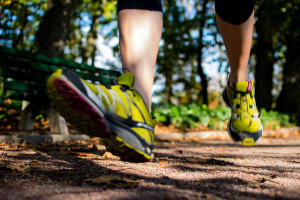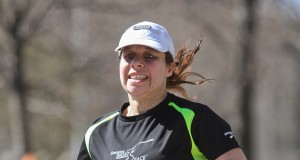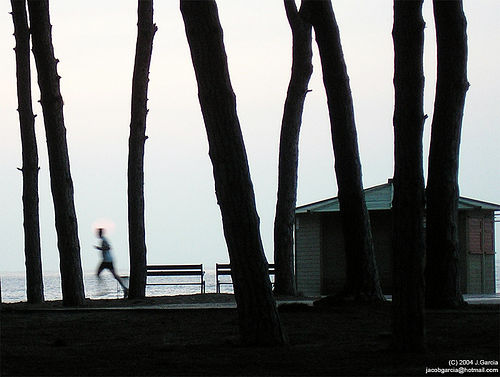At the beginning of 2014, I had grand plans for my running. I was going to run my first 30K race with a view to building up from there to a full marathon by 2016. I already had eight half-marathons under my belt, so while I knew it would be a challenge, I felt that it would be achievable. I registered for the Around The Bay 30K which takes place in March, and I drew up an ambitious but doable training plan.
The plan got derailed when the Polar Vortex hit. The temperatures were lower than anything I have ever experienced. Even with all of winter running gear, I wouldn’t have been able to handle running in that cold. The bigger obstacle, of course, was the ice. There were sheets of it on the roads and sidewalk that were inches thick in places. Even the most seasoned of winter runners were staying indoors.
As a result, I was forced onto the treadmill for most of my training. I did do a couple of grueling runs in heavy snow, but for the most part, I was clocking up 18K runs and more at the gym. A month before the 30K race, conditions were still too severe for outdoor winter running, and I decided to pull the plug on my training. I did not think it would be wise to attempt my longest ever distance right at the end of the worst winter in recorded history.
I went with Plan B: I sold my bib for Around The Bay and instead registered for the 30K Midsummer Night’s Run, which happens in August. That way, I would have the summer to train in safer conditions.
Enter the Ankle Of Doom. More than 20 years ago, my left ankle was seriously injured. In spite of a lot of medical intervention over the years, it has never really been right since. It always hurts for about 24 hours after a long run, but as long as it recovers quickly, I can live with that one day of pain each week. Except that this summer, when I was running distances of 22K and more, my ankle wasn’t recovering. It was constantly hurting and I developed a semi-permanent limp. When I set out for my long runs each week, I was still in pain from the previous week.
I knew I was pushing myself too hard, but I kept telling myself that it would improve, that all I needed was time for my body to get used to the longer distances. Even though I knew this wasn’t working, I was continuing on with desperate hope.
I was finally forced to face up to reality one day in July, while I was doing 25K along the lakeshore trail. Ankle Of Doom throbbed the entire time throughout the first half of the run. As I reached my turnaround point, I knew I was in trouble. I took a two-minute walking break and then, feeling a little better, I started running slowly again. About 3K later, I was feeling OK, so I decided to kick up my speed a notch. Five minutes later, I felt an almighty twinge in my ankle, as if someone had pulled back on an elastic and then released it.
There was instant agony. I could still put weight on my ankle, but with every step, I felt as if a hot poker was being skewered through my foot. I forced myself to continue: I was on a trail, nowhere near a road, and I did not have the option of calling my husband to come and pick me up. Only 8K to go, I kept telling myself. You can run 8K in your sleep. This is nothing for you.
8K is excruciatingly long when every step feels like torture. My ankle got more and more wobbly after every step, and I knew that if I wasn’t careful, it wouldn’t be able to carry me all the way home. For about 3K, I alternated fifty steps of walking with fifty steps of running. The counting definitely helped – it gave my mind something to focus on other than the pain, and alternating walking with running enabled me to keep going. Those three kilometres or so went a lot more quickly than I thought they had.
But then I reached a point of meltdown. I sank down onto a rock facing the lake and burst into tears. By this point, I had less than 5K to go, so I knew that I would make it home. It would take a while, but I would get there. But the realization hit me that I would have to forego the 30K. I knew that in all likelihood, I would never get to achieve my dream of running a full marathon.
I went through the rest of the season in a kind of haze. I switched my 30K registration to 15K and had a good race, and I ran my autism fundraising half-marathon, which also happened to be my 10th half-marathon. A doctor told me that if I concentrated on rehab exercises for my ankle for the next year, I might be capable of training for a marathon.
But I’ve decided that enough is enough. After having pushed myself very close to the point of not being able to run at all, I have accepted that a marathon is not a viable goal for me. I am proud of the fact that I can run half-marathons – for someone who, let’s face it, is not naturally athletic, that’s quite an accomplishment.
And so instead of hurting myself trying to chase a goal that could permanently disable me from running, I am going to improve on distances that I have already accomplished. I am going to get my 10K time back to under 1:03:00, and I am going to run a sub 30-minute 5K. Best of all, in 2015, I am going to run a half-marathon in under 2:15:00.
As modest as these goals are, I have my work cut out for me. But instead of making me weaker, working toward these targets will make me stronger.
Am I sad about giving up on the marathon dream? Of course I am.
But I would be sadder if pursuing the dream took away my ability to do anything at all.
This is an original post by Kirsten Doyle. Photo credit: Ludo Rouchy. This picture has a creative commons attribution license.












